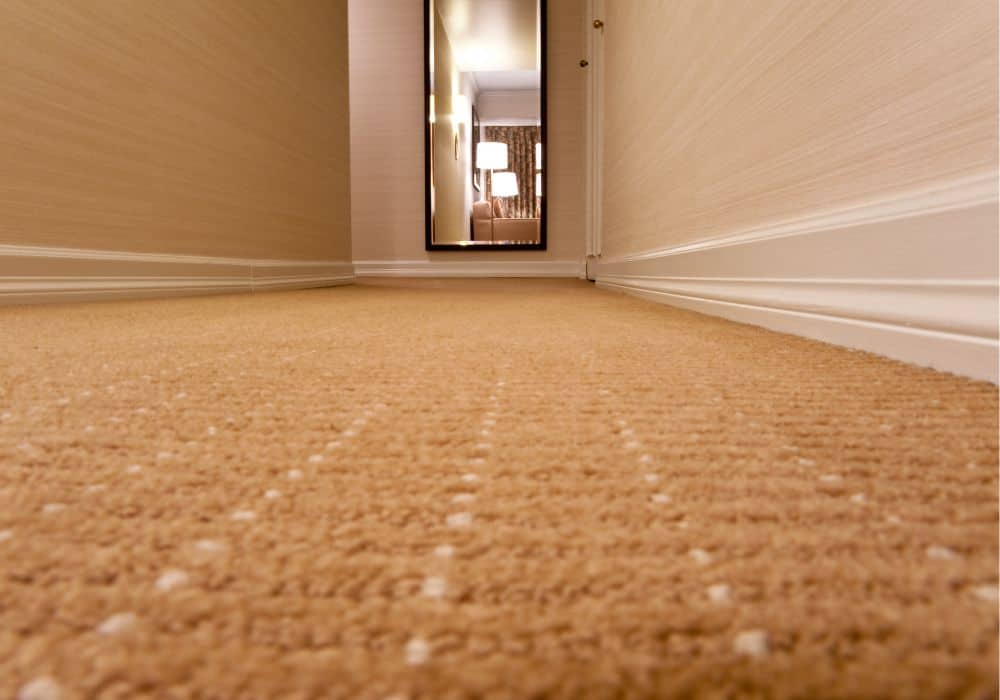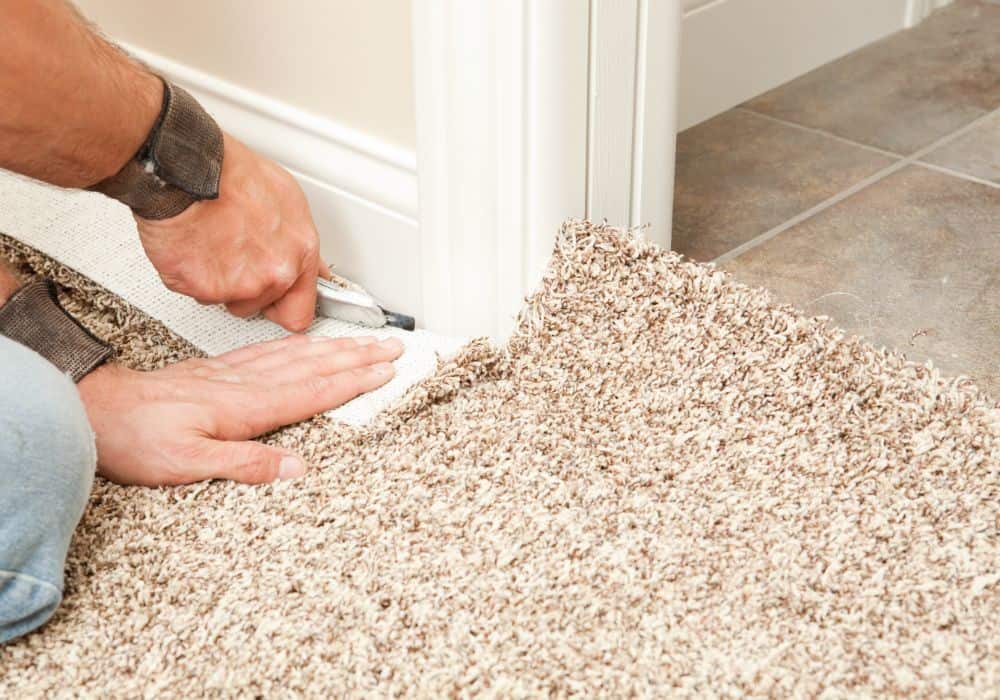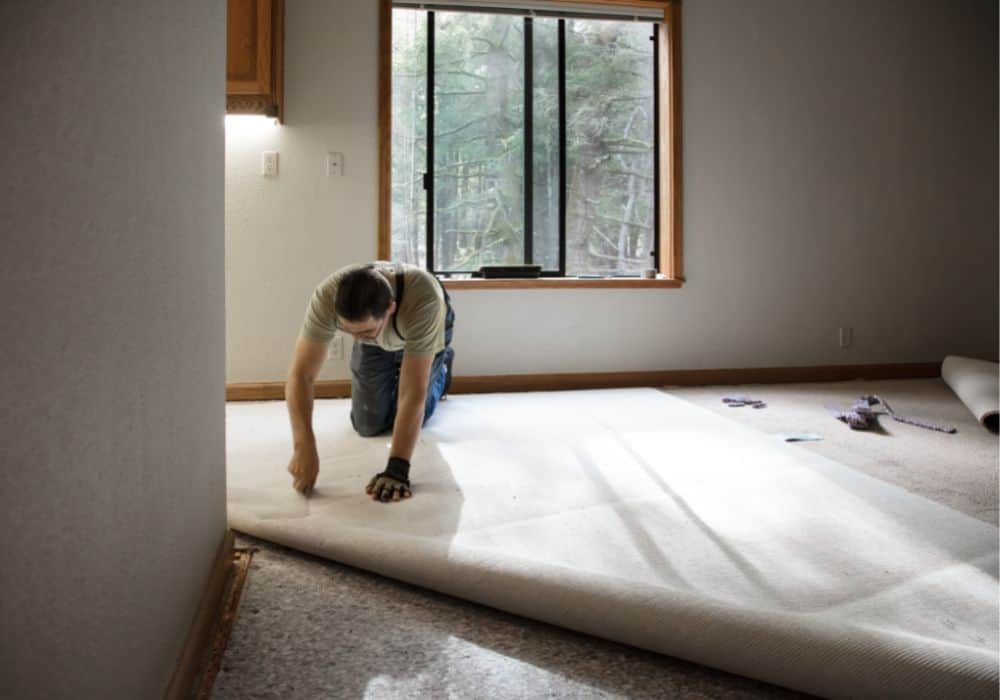Laying carpet is a great way to transform the appearance of your home. Plus, it can make a room feel ultra-cozy and add a layer of comfort.
If you have tile flooring, you may be wondering if there is any way to have carpet without the hassle and expense of tearing up your flooring first.
You may also be wondering if you can put carpet over tile in a house or apartment that you are renting. So, can you put carpet over tile? Keep reading to find out!
Table of Contents
Can You Put Carpet Over Tile?
Can you put carpet over tile? The good news is, yes! In most cases, you can put carpet over tiles easily. It is also more cost-efficient to lay your tiles directly over your tile than tearing them out first.
When putting carpet over your tile, you will want to make sure you choose a high-pile carpet or twist-pile carpet vs. a low-pile carpet. A high-pile carpet will add enough cushion to ensure you can’t feel the tile underneath your carpet.
Thin carpets over tile also get cold and are not as aesthetically pleasing as more plush carpets. I also recommend investing in a good underlay that’s thick, at least 10 mm.
There are, however, a few factors at play when determining if you should put carpet over your tiles before you invest the money into carpeting and tools.
The Condition Of Your Tile
One of the most important factors to consider is whether or not your tiles are in good condition. A little bit of damage is ok, such as scratches. Even some minor cracks are ok.
However, if your tile flooring is broken, crumbling, or weak and has a hollow structure, you will have to tear out your tile before installing the carpet. You can tell if it has a hollow structure because it sounds drummy when you tap on it.
If your tile is in bad shape, and you can’t afford to completely redo it, try finding a big area rug to cover up the parts you want to be covered.
The Spacing Of Your Tile
Another factor to consider is the spacing of your tile. Some tiles have wide gap lines, creating tile spaces over an inch wide!
This will create a major problem not only with the carpet installation process but you will also be able to feel the dips in the carpet as you walk, even after you use an underlay.
If you are dead set on installing carpet over tile with wide grout lines, it is best to call a professional. They can help you figure out what you can do to remedy the problem if there is anything you can do.
Why You May Want To Put Carpet Over Tile
Everyone has a different reason for wanting to install carpet over their tile flooring. Here are a few good reasons why you should put carpet over tile, in case you need to talk into it, or maybe convince someone else why it’s a great idea!
1. You Want To Upgrade Your Space
This is the number one reason people choose to put carpet over tile. Hard flooring like tiles is great in kitchens and bathrooms, but in other spaces like living rooms or bedrooms, it can feel cold and unwelcoming.
Putting carpet in these places instead will open up your room and make it feel homier. You may also be dealing with tile that is outdated and ugly. In this case, putting carpet over it is a great way to hide it and make your space feel more contemporary.
2. You Have Young kids
Another good reason to put carpet over tile is if you have a new baby or a toddler in your home. Babies learning to crawl and walk are prone to falls, along with toddlers who have been walking for a while but are just adventurous or clumsy.
In this case, installing carpet is a great way to make sure they don’t damage their developing heads when they fall because the carpet will soften the blow.
It is also a good idea to install carpet over tile in your toddler’s bedroom, especially if they are transitioning out of a crib. Toddlers move around a lot when they sleep, and you wouldn’t want them to fall out of their
bed and hit their heads on the hard tile.
3. You Run Cold
Some people run hot; some people run cold; it’s just life. If you are lucky enough to be in the mix of ones that run cold, you know how painful it can be to go from being warm and cozy under your blankets to stepping on freezing cold tile. This is not ideal.
Not only that, but it’s a fact that rooms with tiles stay colder. This is because tile is a heat conductor. It sounds like it should be the opposite, but it isn’t. Tile flooring pulls heat away from your feet much more quickly than any other type of flooring aside from concrete.
4. Your Tile Is Damaged
Maybe the only reason you want to put carpet over your tile is to hide the hideous flaws. Maybe the person that lived there before you moved furniture around without protecting the surface and left a bunch of ugly marks on the tile.
Either way, ugly, scratched-up flooring is extremely unappealing and a very good reason to cover it up with carpet.
How To Install Carpet Over Tile
If you have finally decided to go for it, you are probably wondering how you can make it happen. You can do it yourself, or you can hire a professional.
Hiring a professional will be an extra cost with labor charges and fees, but if you are not comfortable or can’t obtain the right materials and tools, it will be worth it to have a professional handle it.
Alternatively, you can use carpet tiles if you don’t want to hassle with installing carpet traditionally. These carpet tiles are self-adhesive, so you just peel and stick them tile by tile.
Step 1: Measure Your Room
Before you begin, measure around the perimeter of the room to get the square footage. This will let you know how much carpet and underlay you need to purchase.
Measure the length of the room and the width of the room, then multiply the two together. If the room is 10 ft by 10ft, the square footage will be 100 sq feet.
Step 2: Remove Your Furniture
Remove all of your furniture in the room you want to carpet. Be sure to put furniture pads underneath the legs of your furniture if you do not already have them if you don’t want to damage all of your tiles.
Step 3: Clean Your Floors
Next, clean your floors thoroughly using a heavy-duty cleaner. You don’t want dirt and grime lying underneath your carpet. Scrub the tile with a thick bristle brush until it’s clean. You may have to clean it multiple times to get the excess buildup out of the tile grout.
Step 4: Glue Your Tack Strips
Next, use heavy-duty construction adhesive to glue your tack strips to the tile. Glue the strips about a quarter of an inch away from the baseboards around the entirety of your room.
If the strips do not lay straight or your walls are irregular, you can cut them into pieces so that they lay correctly. You will need to let the strips sit overnight to let the glue dry.
If you don’t want to damage your tiles with glue, you can use heavy-duty double-sided tape made for tough projects or adhesive tackless strips. This is a great option if you are a tenant living in a rental house or apartment.
Step 5: Lay Down Your Underlay
After your tack strips are set, or your double-sided tape is in place, it’s time to roll out your underlay. This is the carpet padding that goes between your floor and your carpet. Begin rolling the padding out, pulling it tight to the corners of the room.
Cut the excess carpet to fit your space, cutting right against the outside of the tack strip or double-sided tape with a utility knife. If you have multiple pieces of underlay, you can tape them together with special duct tape meant for these purposes.
Step 6: Lay the carpet
Once you have your underlay down, you will roll out your carpet in the same fashion. However, you will cut your carpet right up against the surface of your walls, so there is no space in between.
Make sure you pull your carpet tight, so there are not any gaps or folds. Your carpeting should fall flush against the sides of the room.
Step 7: Lock it into place
Now, it’s time to lock your carpet into place. Simply go along the carpet edges and apply pressure, so the carpet sticks to the tack strips or double-sided tape.
You should not have any nails from the tack strips sticking up out of your carpet, so if you see this happening, you should stop pressing the carpet down and trim your tack strips accordingly.
Conclusion
Putting carpet over tile is a great way to hide imperfections, upgrade your living space, or add a bit of warmth.
Make sure you follow the proper steps to ensure your carpet is installed correctly and always take appropriate safety measures when tackling any DIY project.
We hope you found this article helpful! If you have any questions or concerns, let us know in the comments below! We love to hear from our readers!


